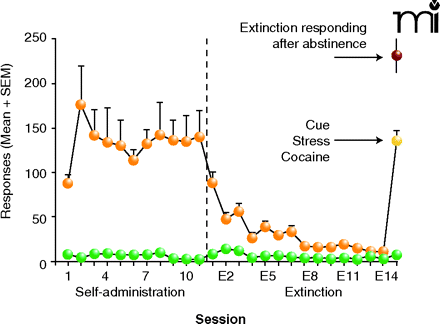
- Institution: Stanford Univ Med Ctr Lane Med Lib/Periodical Dept/Rm L109
- Sign In as Member / Individual
Animal Models and Brain Circuits in Drug Addiction

Development and Expression Phases of Addiction in an Animal Model. In the first phase of the paradigm, animals are trained for twelve days to self-administer cocaine by means of lever pressing (orange circles; drug delivery is accompanied by a cue—typically a light and/or a tone. In the second phase, animals either undergo "abstinence" (i.e., they are maintained in their home cages without exposure to the operant chamber) or "extinction training" during which no drug is administered in response to lever pressing (E1 –E14). At the end of this second phase, animals (regardless of whether "abstinent" [red] or "extinguished" [yellow]) are presented with the cue that had accompanied each drug infusion during self-administration, a mild stressor (typically foot shock), or the drug itself. Each of these stimuli reliably overcomes extinction training and the animals will press the lever even though no drug is delivered. This reinstatement of lever pressing is considered to be a bout of drug seeking. Note that, although reinstatement conditions mimic those of E1 for "reinstated" animals, the "abstinent" group responds to reinstatement far more greatly than do the extinction-trained animals. (Green represents responding on the control lever, which never delivers drug in response to lever pressing.)


